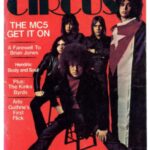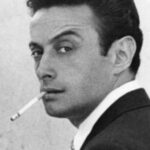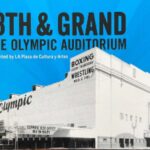-
Featured News
The MC5: A Eulogy
 By Doug Sheppard
And then there were none. Five equals zero. The morning of May 9, 2024, the last surviving member of the MC5, drummer Dennis Thompson, died while recovering from a heart attack—
By Doug Sheppard
And then there were none. Five equals zero. The morning of May 9, 2024, the last surviving member of the MC5, drummer Dennis Thompson, died while recovering from a heart attack— -
Featured Articles
The Beatles: Their Hollywood and Los Angeles Connection
 By Harvey Kubernik
JUST RELEASED are two new installments of the Beatles’ recorded history, revised editions of two compilation albums often seen as the definitive introduction to their work.
Or
By Harvey Kubernik
JUST RELEASED are two new installments of the Beatles’ recorded history, revised editions of two compilation albums often seen as the definitive introduction to their work.
Or -
The Beatles: Their Hollywood and Los Angeles Connection

By Harvey Kubernik
JUST RELEASED are two new installments of the Beatles’ recorded history, revised editions of two compilation albums often seen as the definitive introduction to their work.
Originally released in 1973, 1962-1966 (‘The Red Album’) and 1967-1970 (‘The Blue Album’) are now expanded for their new 2023 Edition packages by Apple Corps Ltd/Capitol/Ume. The collections together span the Beatles’ entire recorded canon with 75 tracks, including the John Lennon/Paul McCartney written “Love Me Do,” the Chuck Berry-penned “Roll Over Beethoven,” to their last, “Now And Then.” The collections showcase 21 newly-added tracks (twelve on ‘Red’ and nine on ‘Blue’).
In recent years, several 1967-1970 tracks and a few from 1962-1966 have received new stereo and Dolby Atmos mixes for The Beatles’ Special Edition album releases, including Sgt. Pepper’s Lonely Hearts Club Band (2017), The Beatles (‘White Album’) (2018), Abbey Road (2019), Let It Be (2021), and Revolver (2022), as well as new stereo mixes for The Beatles’ 1 (2015).
All tracks not also featured on those releases have been newly mixed in stereo and/or Dolby Atmos by Giles Martin and Sam Okell at Abbey Road Studios, aided by WingNut Films’ audio de-mixing technology. Both collections include new essays written by journalist and author John Harris.
##
“Hollywood and the Beatles were the two greatest romances of the 20th century,” suggests writer, poet and deejay Dr. James Cushing, an alum from UC Irvine. “What did they have in common? How did they intersect? How did one of these great affairs learn from the other?”
It’s not a secret why the Beatles had an emotional, musical, physical, and spiritual relationship to Hollywood and Southern California.
In the mid-seventies John Lennon moved to Los Angeles, liked it too much, and returned to New York to retire. Paul, George, and Ringo all purchased homes in Los Angeles County; George died in 2001 and cremated at Hollywood Forever Cemetery. His funeral was held in Pacific Palisades at the Self-Realization Fellowship Lake Shrine.
Thinking of Lenny Bruce

By Harvey Kubernik
On August 3, 1966, stand-up comedian, social critic, satirist, and philosopher Lenny Bruce was found dead at age 40 inside his Hollywood Hills home from an acute overdose of morphine.
He died near where I sold newspapers and distributed admission tickets to The Preview House on Sunset Boulevard at the time. It was front page headlines in Los Angeles, and many folks in the neighborhood and around town were deeply saddened.
Fifty seven years ago over 500 mourners paid their last respects at Eden Memorial Park Cemetery in Mission Hills, California. Principal Eulogy was read by Phil Spector who paid for the funeral.
At least Lenny Bruce was not forgotten around Southern California after his 1966 burial. In August 1968, The Los Angeles Free Press presented a Murray Roman-hosted LennyBrucemas musical event at the Cheetah pier in Venice. Over 20,000 people attended.
Around Lenny Bruce’s freedom of speech advocacy, the lingering obscenity busts, and numerous arrests, Lenny’s bold stand-up comedy performances and public observations were not routines, but podium examples of unfiltered verbal reality coupled with reflections about race, religion and relationships. His rant on actor Bela Lugosi was always a Halloween favorite on many turntables.
During 1958-1976, my family and I would occasionally see Lenny Bruce, Sandy Baron, Mantan Moreland, Richard Pryor, Al Jarvis, Don Peake, Jan Alan Henderson, Rodney Bingenheimer, Sonny Bono, Don Randi, Nik Venet, Micky Dolenz, and many comics, actors, actresses, directors, screenwriters, movie studio heads, prostitutes, pimps, bands, and the Vine Street-based Musician Union 47 session musicians around town at the Hollywood Ranch Market and Canter’s Delicatessen. These places were open 24 hours.
Bruce was a frequent guest on black and white television shows I watched on my parent’s television set, In 1957 I saw the Teddy Bears, (Phil Spector, Marshall Lieb and Annette Kleinbard) on the local KTLA TV program Rocket to Stardom, sponsored by salesman Bob Yeakel, who used to hawk Oldsmobiles during the broadcast from his showroom. Lenny Bruce with Joe Maini, Jack Sheldon, Dennis Hopper and Jim Keltner also appeared on the show.
“In spring, 1964, I glimpsed Lenny as he was going into a theater at La Brea Avenue and Hollywood Boulevard,” recalled author/musician Jan Alan Henderson in a July 2023 interview we did. “We were going to ABC Books to buy the first books on the Beatles on the way to Le Conte Junior High in East Hollywood. My mother knew Lenny’s wife Honey as they were neighbors. My mom was a volunteer for the United Way and the Bruce household was in the district. Lenny was the one who fought for First Amendment rights.”
UNO MUNDO (It Came From East Los Angeles)

By Harvey Kubernik
Dedicated to Mamie Van Doren Con Art Aragon
This spring and summer at select movie theaters and on cable television’s Spectrum SportsNet, filmmaker Stephen DeBro in his sports and music documentary 18th & Grand: The Olympic Auditorium, tells the story of Los Angeles through the distinctive voices of boxers, wrestlers, roller derby skaters and rock musicians who performed at the Olympic Auditorium. The venue opened in 1925.
In 1951, rhythm & blues concerts were held on the premises. During the 1969-1970 period, Little Richard, Frank Zappa, Mountain, Jack Bruce and Ten Years After were on the marquee. In the eighties and nineties, Public Image Ltd debuted there, and soon afterwards, monthly concerts were promoted by Gary Tovar and Goldenvoice Productions headlining Dead Kennedys, the Dickies, the Circle Jerks, Bad Religion, Suicidal Tendencies, and X. Music videos for Bon Jovi, Kiss, Air Supply, Janet Jackson, and Rage Against the Machine were produced in the landmark location at the corner of 18th Street and Grand Avenue, just south of the Santa Monica Freeway in downtown L.A.
“From the beginning the Olympic was an extension of Hollywood’s back lot,” underscores DeBro. “So many great films were shot at the Olympic, starting with Buster Keaton’s Battling Butler, The Three Stooges Punch Drunks, The Manchurian Candidate, Raging Bull, the Rocky series, Million Dollar Baby, The Turning Point, Requiem for a Heavyweight, The Sting II, and in 2003, Charlie’s Angels: Full Throttle. There were hundreds of TV shows and commercials.”
It’s now the Korean-American Glory Church of Jesus Christ.
The 18th & Grand: The Olympic Auditorium soundtrack is by War, Shuggie Otis, Charles Wright & the Watts 103rd Street Band, Queens of the Stone Age, Dead Kennedys, the Weirdos, Cannibal & the Headhunters, Quetzal and Jungle Fire (Albert Lopez).
DeBro, author and music/culture historian, Gene Aguilera, along with LA Plaza de Cultura’s Karen Crews Hendon and Esperanza Sanchez, are serving as curators of the museum’s forthcoming August 11, 2023-May 12, 2024, 18th & Grand: The Olympic Auditorium exhibition recounts the 80-year history (1925-2005) of the Olympic Auditorium, the home for visceral entertainment in Los Angeles with artifacts from all facets of the venue’s storied history. The exhibit will be held at La Plaza de Cultura Y Artes Museum, 501 N. Main Street, Los Angeles, California 90012.
18th & Grand: The Olympic Auditorium reminds us about nearby East Los Angeles and adjacent Boyle Heights, east of the Los Angeles River. These two Los Angeles’ Chicano/Mexican-American communities gave us Top Forty music hitmakers, Verve Records’ founder Norman Granz, record producers and songwriters Herb Alpert, Lou Adler, H.B. Barnum, Mike Stoller, as well as musician/deejay Lionel “Chico” Sesma, Black Eyed Peas’ will.i.am, and Gene Aguilera.